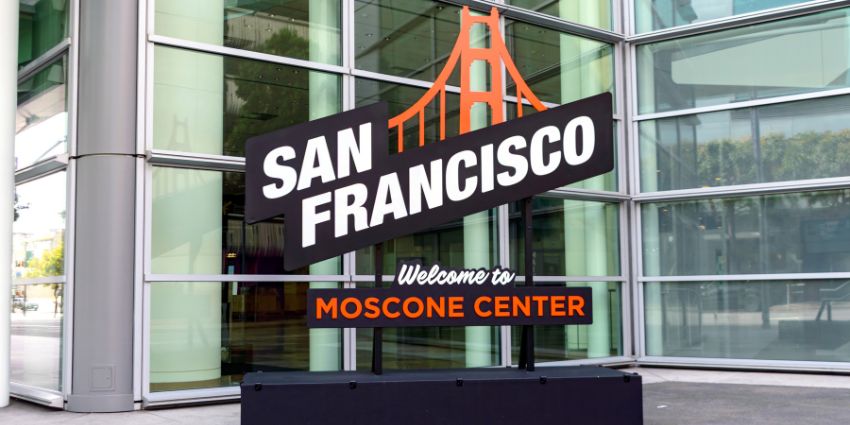The modern workplace is going through a period of constant transformation. Though employers are encouraging staff to return to the office, flexible work arrangements are still in high demand.
Workspaces are being reimagined as companies strive to create collaboration hubs, with more open spaces designed to nurture group work between on-site and remote attendees. Studies show that traditional, static workspaces and meeting rooms are becoming a thing of the past and individual workspaces are being replaced with hot desking initiatives. In fact, according to an IDC report, 38% of organizations say that collaboration is a key driver in their office redesign decisions. Businesses need to create environments that are just as flexible, agile, and scalable as their workforce.
So, how do you ensure you’re building office spaces that can adapt rapidly to changing organizational needs? How do you find tech that can outlast the typical “refresh cycle” and flex based on new working arrangements and priorities? And how should you allocate budgets to maximize long-term return on investment? Here’s everything you need to know.
The Key Considerations for Futureproof Collaboration Solutions
To thrive in the new era of work, businesses in all industries need to take a new approach to workplace design. It’s time to begin exploring new innovations in AI and automation, to enhance employee experiences and replace static technology with modular, flexible systems that can scale as demand grows.
Additionally, businesses need to ensure they’re prioritizing collaboration solutions that not only deliver “investment protection” but ongoing support for data security, particularly as users continue to experiment with new devices, IoT connectivity, and cloud services.
1. Selecting Scalable, Upgradable Technologies
As modern meeting rooms, office neighborhoods, and hot desking spaces continue to evolve, companies can’t afford to waste resources on inflexible systems. They need their technologies to be powerful and agile enough to adapt to future needs and accommodate organizational growth.
Whether businesses are exploring new flexible work arrangements, expanding team sizes, opening new offices or right-sizing real estate footprint, their technology needs to scale to meet increasing demands. Simply replacing technology every time office demands change is no longer an economically viable option.
Fortunately, leading AV and collaboration technology providers are embracing concepts like “modularity”, which allow users to mix and match hardware, and make simple, incremental upgrades or add extensions to their existing systems. They’re also taking a more comprehensive approach to ensuring firmware and software updates are available to maintain state-of-the-art performance and security, and add new features and functions for users to get more out of their existing technology investments.
For instance, Shure’s Microflex Ecosystem not only provides companies a highly modular set of audio solutions for meeting rooms and collaboration spaces of all sizes, but it also gives users access to new, add-on features throughout the lifespan for their system, and keep technologies up to date via a comprehensive cloud-based platform for centralized device management and maintenance.
2. Prioritizing Interoperability and Support for Future Innovations
Interoperability has always been crucial to future-proofing collaboration solutions. Businesses need to ensure the systems they invest in, whether it’s AV technology, or meeting room software, can work seamlessly with both emerging and existing IT infrastructure.
Choosing systems that are certified for and can easily connect with enterprise communication tools and software platforms minimizes the need for extra support with integrations, and reduces the risks caused by gaps between disconnected systems, such as data silos and poor user experiences.
Selecting solutions that not only adhere to current industry standards but are flexible enough to adapt to changing needs will be crucial to investment protection in the years ahead. This is particularly true as new innovations continue to reshape the workplace. Modern collaboration solutions shouldn’t just work with leading platforms like Microsoft Teams or Zoom. They need to be able to provide the necessary performance required to allow users to get the most out of emerging solutions in the world of AI and automation.
After all, McKinsey found almost a third of companies are using generative AI for at least one business function. If the collaboration solutions businesses choose today can’t adapt to the rise of generative AI, companies risk having to redesign their entire office environments based on every new trend and evolution. Tools like Copilot can only transform team collaboration if the information shared in a meeting room can be effectively captured by AV hardware that provides the highest levels of intelligibility, enabling more accurate transcription, speaker attribution and voice recognition.
This makes investments in superior solutions like the Shure Microflex Ecosystem crucial to staying competitive, as it gives companies the “built-in horsepower” they need to adapt to new technology trends and get the desired productivity improvements out of AI innovations.
3. Ensuring Ongoing Reliability and Performance
As hybrid and flexible work initiatives continue to evolve, business leaders can’t afford to underestimate the importance of high-quality, reliable systems that help to synchronize and align team members consistently. Companies will need to rethink how they invest in technology, with a focus on long-term sustainable value, rather than simply attempting to minimize upfront costs.
Investing in high-quality solutions today often means benefiting from greater reliability and performance in the future. This means fewer support calls to manage, less downtime, and improved user experiences throughout the workplace. High-quality solutions offer more longevity, reducing the need for constant technology updates and refreshes. Additionally, leading vendors can even provide better support services, such as proactive monitoring and extended warranties, reducing the risk and impact of potential equipment issues. Advanced support features ensure your technology always runs at optimal efficiency, reducing resource and energy costs, and improving user experiences.
High-quality, durable audio and video technology also offers companies a way to reduce electronic waste. Adaptable solutions designed to outlast typical refresh cycles reduce the frequency of hardware disposal, and so can also contribute to corporate sustainability objectives.
What’s more, prioritizing quality can actually support long-term financial performance for an organization. A report published by IDC last year found that 72% of organizations that thrive financially are likely to already use professional audio equipment. After all, sound quality directly affects communication, and poor communication leads to poor performance. When employees struggle to hear and understand each other, they waste time on misunderstandings, clarifying, and repeating information.
Additionally, investing in high-quality audio is crucial to creating a satisfying employee experience. It eliminates the “circle of frustration” that hinders team performance. Clear and effective communication empowers employees, enhances collaboration, and drives better business outcomes.
4. Preparing for the Future of Security
Preserving security and compliance in the hybrid workplace is a significant concern for many organizations today.
As data security and corporate security policies continue to develop, business leaders will need to ensure their collaboration solutions can adapt to new demands. Video conferencing systems (both hardware and software) will need to offer advanced security features, such as multi-factor authentication options, and end-to-end encryption.
Businesses will also need to ensure vendors offer regular security patches for software, and access to tools that allow them to control where data is stored, how network connections are managed, and even implement network segmentation methods.
Working with a vendor like Shure that makes security a priority, and meets or exceeds industry best practices, alongside international data protection regulations will be critical in the years ahead. Businesses will need to ensure they’re taking every precaution to protect data, users, and employees, to avoid reputational damage, fines, and downtime.
5. Partnering with Supportive Vendors
Finally, to remain truly agile and resilient as new workplace evolutions emerge, business leaders will need to think carefully about the vendors they partner with. Choosing a collaboration vendor that supports flexible, adaptable and scalable technologies, and enables teams to access the latest innovations in AI and automation with ease is crucial.
Double-down on searching for vendors that are well-known for their reliability, and commitment to innovation and development. Think about how the vendors you work with will help you scale. They should provide access to firmware and software upgrades, new modular systems and technology.
It’s important to think about service options too. Engaging in long-term partnerships with vendors that can offer access to extended warranties, end-to-end technical support, training, and professional services will help companies to protect their investment, and maintain system performance long-term.
Your chosen vendors should also have a strong enough global presence to ensure you can achieve the same consistent performance, and access the same ongoing support as your business expands across geographical regions, and hires global team members.
The Long-Term Value of Futureproofing Collaboration
Initially, investing in futureproof collaboration solutions can seem complex. To access the most agile and adaptable technologies that prioritize user experience, security, and innovation, businesses will need to spend a little extra up-front. However, while the initial investment in high-quality technology can be higher, the long-term benefits and return on investment are better too.
A longer operational lifespan enabled by more robust technology and predictive maintenance reduces the costs related to frequent upgrades and repairs. Durable and flexible products that can adapt to new requirements reduce the cost of having to replace entire ecosystems of technology with every new trend that emerges.
Plus, higher-quality systems improve user experiences, reducing the risk of employee turnover, minimizing productivity issues, and enhancing business performance. An established, trustworthy vendor helps businesses make the most of their technology and enhance return on investment.
With the right strategy, companies can both prepare more effectively for the future, reduce long-term expenses, and achieve better business results.







